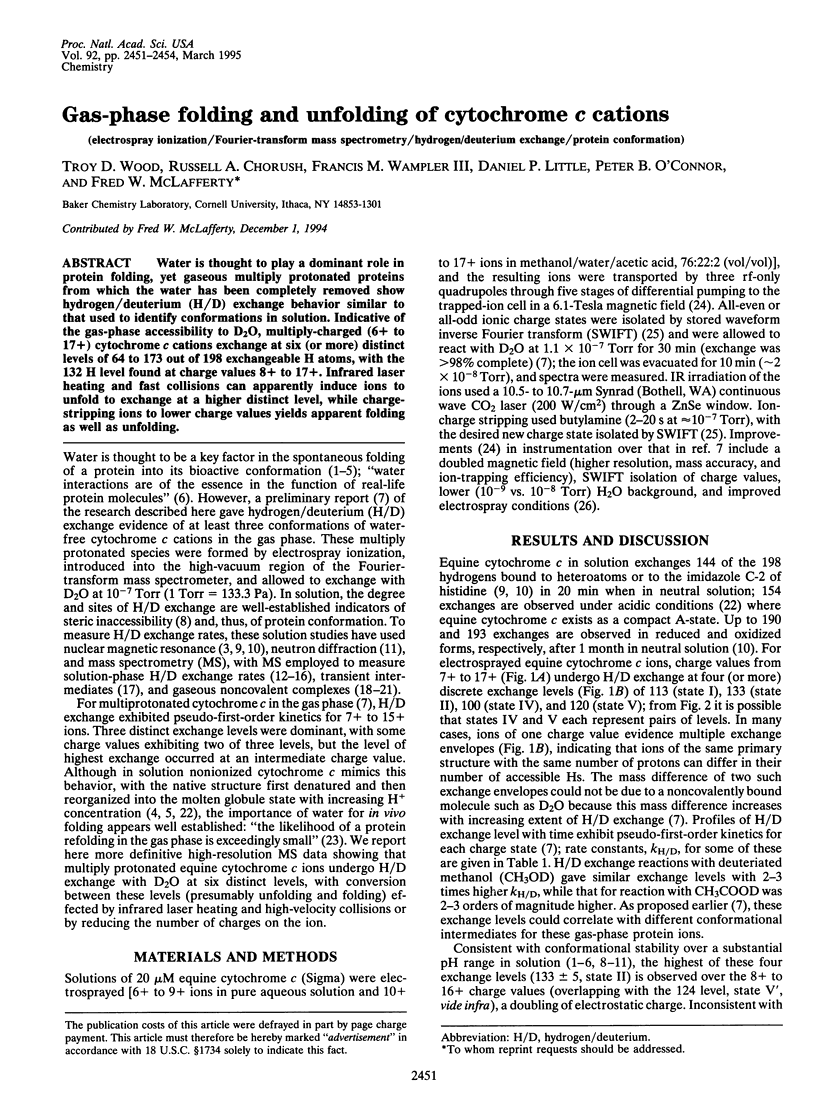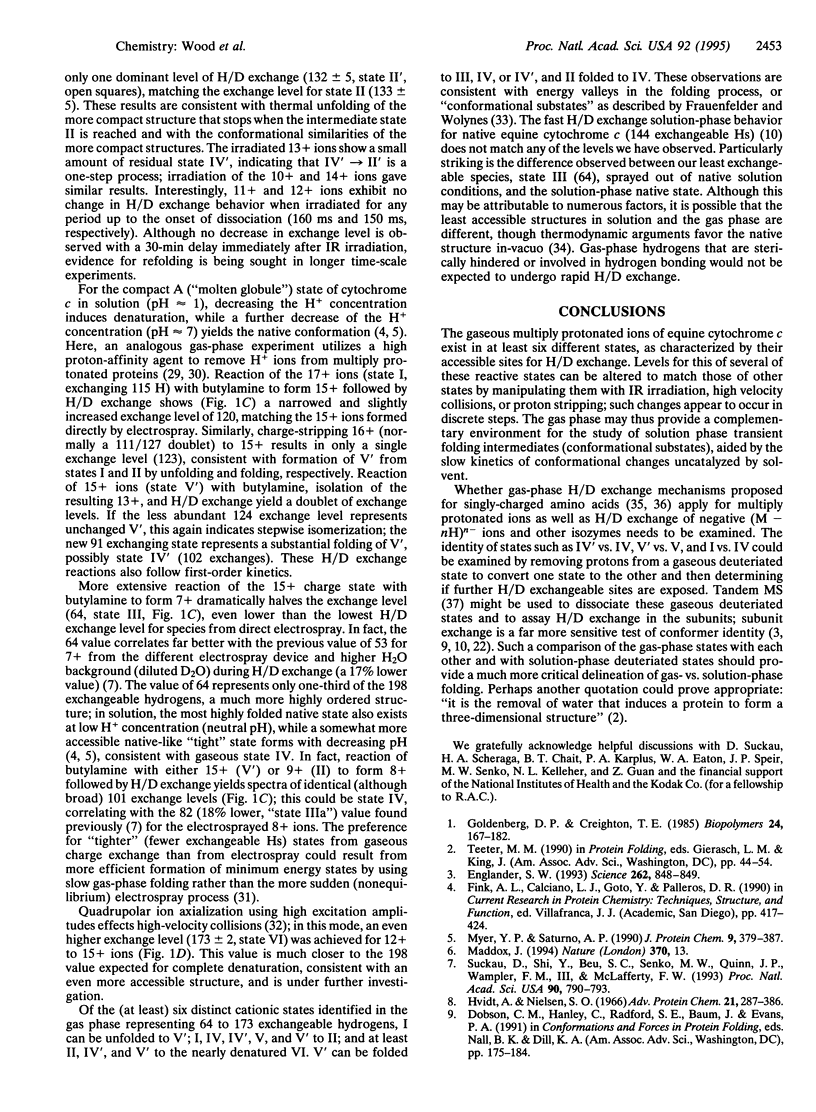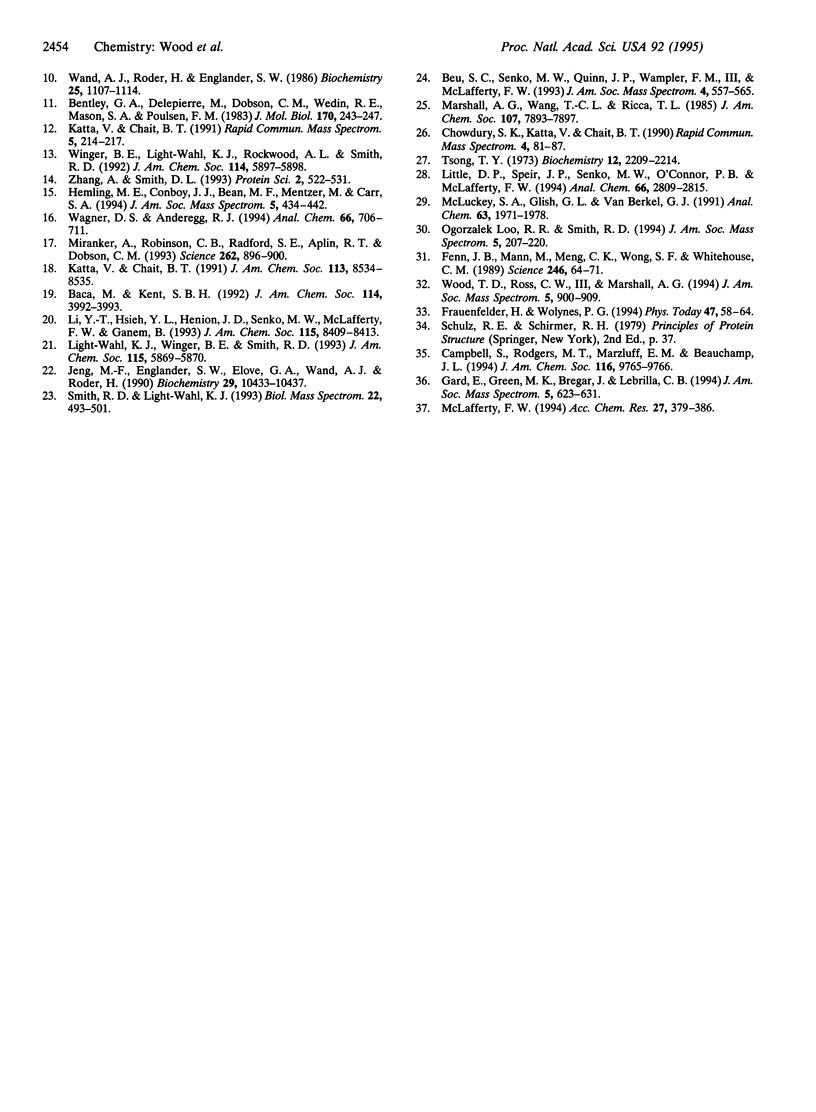Abstract
Water is thought to play a dominant role in protein folding, yet gaseous multiply protonated proteins from which the water has been completely removed show hydrogen/deuterium (H/D) exchange behavior similar to that used to identify conformations in solution. Indicative of the gas-phase accessibility to D2O, multiply-charged (6+ to 17+) cytochrome c cations exchange at six (or more) distinct levels of 64 to 173 out of 198 exchangeable H atoms, with the 132 H level found at charge values 8+ to 17+. Infrared laser heating and fast collisions can apparently induce ions to unfold to exchange at a higher distinct level, while charge-stripping ions to lower charge values yields apparent folding as well as unfolding.
Full text
PDF



Selected References
These references are in PubMed. This may not be the complete list of references from this article.
- Bentley G. A., Delepierre M., Dobson C. M., Wedin R. E., Mason S. A., Poulsen F. M. Exchange of individual hydrogens for a protein in a crystal and in solution. J Mol Biol. 1983 Oct 15;170(1):243–247. doi: 10.1016/s0022-2836(83)80235-6. [DOI] [PubMed] [Google Scholar]
- Chowdhury S. K., Katta V., Chait B. T. An electrospray-ionization mass spectrometer with new features. Rapid Commun Mass Spectrom. 1990 Mar;4(3):81–87. doi: 10.1002/rcm.1290040305. [DOI] [PubMed] [Google Scholar]
- Englander S. W. In pursuit of protein folding. Science. 1993 Nov 5;262(5135):848–849. doi: 10.1126/science.8235606. [DOI] [PMC free article] [PubMed] [Google Scholar]
- Fenn J. B., Mann M., Meng C. K., Wong S. F., Whitehouse C. M. Electrospray ionization for mass spectrometry of large biomolecules. Science. 1989 Oct 6;246(4926):64–71. doi: 10.1126/science.2675315. [DOI] [PubMed] [Google Scholar]
- Goldenberg D. P., Creighton T. E. Energetics of protein structure and folding. Biopolymers. 1985 Jan;24(1):167–182. doi: 10.1002/bip.360240114. [DOI] [PubMed] [Google Scholar]
- Hvidt A., Nielsen S. O. Hydrogen exchange in proteins. Adv Protein Chem. 1966;21:287–386. doi: 10.1016/s0065-3233(08)60129-1. [DOI] [PubMed] [Google Scholar]
- Jeng M. F., Englander S. W., Elöve G. A., Wand A. J., Roder H. Structural description of acid-denatured cytochrome c by hydrogen exchange and 2D NMR. Biochemistry. 1990 Nov 20;29(46):10433–10437. doi: 10.1021/bi00498a001. [DOI] [PubMed] [Google Scholar]
- Katta V., Chait B. T. Conformational changes in proteins probed by hydrogen-exchange electrospray-ionization mass spectrometry. Rapid Commun Mass Spectrom. 1991 Apr;5(4):214–217. doi: 10.1002/rcm.1290050415. [DOI] [PubMed] [Google Scholar]
- Little D. P., Speir J. P., Senko M. W., O'Connor P. B., McLafferty F. W. Infrared multiphoton dissociation of large multiply charged ions for biomolecule sequencing. Anal Chem. 1994 Sep 15;66(18):2809–2815. doi: 10.1021/ac00090a004. [DOI] [PubMed] [Google Scholar]
- Maddox J. Does folding determine protein configuration? Nature. 1994 Jul 7;370(6484):13–13. doi: 10.1038/370013a0. [DOI] [PubMed] [Google Scholar]
- McLuckey S. A., Glish G. L., Van Berkel G. J. Charge determination of product ions formed from collision-induced dissociation of multiply protonated molecules via ion/molecule reactions. Anal Chem. 1991 Sep 15;63(18):1971–1978. doi: 10.1021/ac00018a014. [DOI] [PubMed] [Google Scholar]
- Miranker A., Robinson C. V., Radford S. E., Aplin R. T., Dobson C. M. Detection of transient protein folding populations by mass spectrometry. Science. 1993 Nov 5;262(5135):896–900. doi: 10.1126/science.8235611. [DOI] [PubMed] [Google Scholar]
- Myer Y. P., Saturno A. F. Horse heart ferricytochrome c: conformation and heme configuration of low ionic strength acidic forms. J Protein Chem. 1990 Aug;9(4):379–387. doi: 10.1007/BF01024613. [DOI] [PubMed] [Google Scholar]
- Suckau D., Shi Y., Beu S. C., Senko M. W., Quinn J. P., Wampler F. M., 3rd, McLafferty F. W. Coexisting stable conformations of gaseous protein ions. Proc Natl Acad Sci U S A. 1993 Feb 1;90(3):790–793. doi: 10.1073/pnas.90.3.790. [DOI] [PMC free article] [PubMed] [Google Scholar]
- Tsong T. Y. Detection of three kinetic phases in the thermal unfolding of ferricytochrome c. Biochemistry. 1973 Jun 5;12(12):2209–2214. doi: 10.1021/bi00736a005. [DOI] [PubMed] [Google Scholar]
- Wagner D. S., Anderegg R. J. Conformation of cytochrome c studied by deuterium exchange-electrospray ionization mass spectrometry. Anal Chem. 1994 Mar 1;66(5):706–711. doi: 10.1021/ac00077a020. [DOI] [PubMed] [Google Scholar]
- Wand A. J., Roder H., Englander S. W. Two-dimensional 1H NMR studies of cytochrome c: hydrogen exchange in the N-terminal helix. Biochemistry. 1986 Mar 11;25(5):1107–1114. doi: 10.1021/bi00353a025. [DOI] [PubMed] [Google Scholar]


